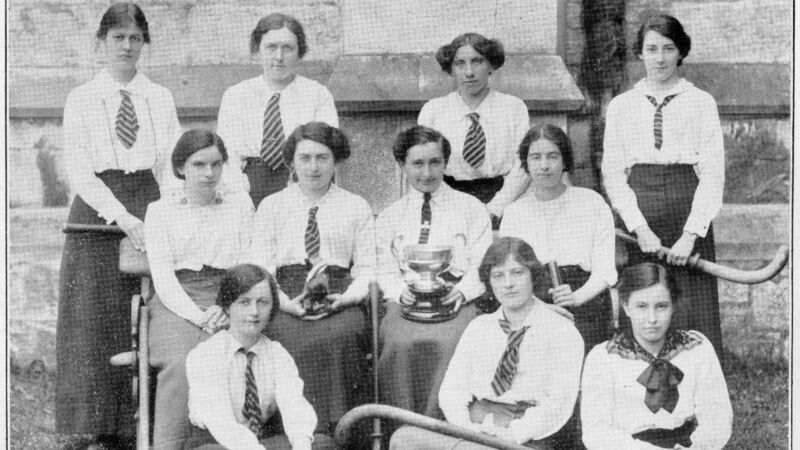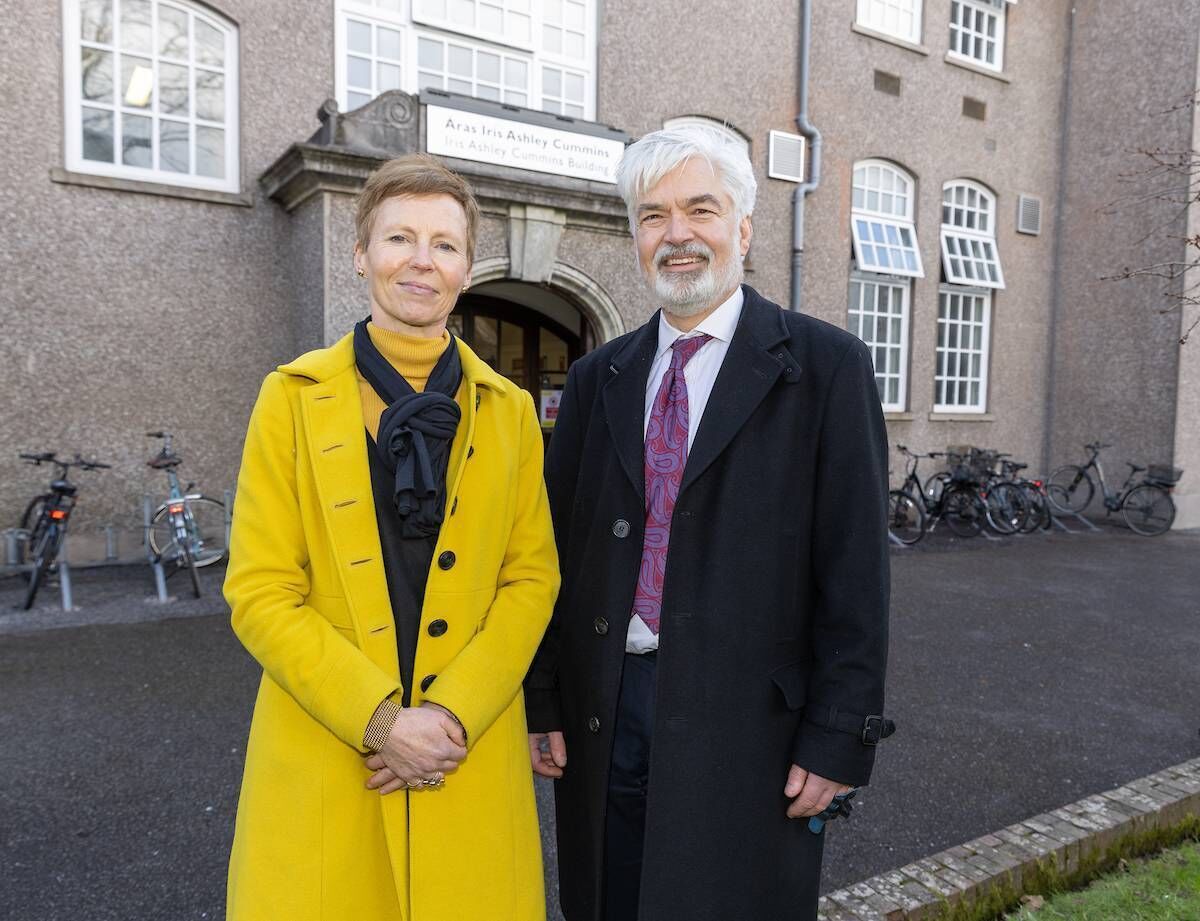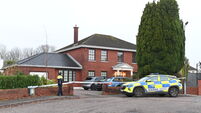Clodagh Finn: UCC names its first building after a female graduate — at long last

Iris Ashley Cummins (centre) pictured with the UCC ladies hockey club after winning the Munster Cup in 1914
What happy, hopeful news. The civil engineering building at University College Cork has just been named after its first female engineering graduate, Iris Ashley Cummins.
It is, incredibly, the first building on campus to be named after a woman. It’s very late in the day — the university was founded in 1845 — but there is still reason to celebrate when the achievements of an overlooked woman are finally written in stone, so to speak.
And Iris Ashley Cummins certainly deserves to be commemorated. Born in Glanmire, Cork, in 1894, she was the first woman to graduate with a Bachelor of Engineering from UCC in 1915. She went on to chalk up a series of ‘firsts’ in her lifetime. She would become the first female land surveyor for the Irish Land Commission, and the first female associate member of the Institution of Civil Engineers of Ireland.
She was also a talented hockey player, winning her first cap for Ireland in 1914. More than a decade later, in 1925, she captained the Irish team on its seven-week tour of America.
The team blazed a victorious trail, scoring over 100 goals in 13 games and beating the Americans who played a scientific game but, as the players told this newspaper, were “not quick enough on their feet”.
They also visited the White House on the invitation of US president Calvin Coolidge.
The tour and Iris Ashley Cummins’ sporting career are of interest, but it is what she had to say about women and engineering that resonates ahead of International Introduce a Girl to Engineering Day tomorrow.
It is also worth noting that more than a decade passed before a second woman graduated with a degree in engineering from UCC – Cecelia O’Connell in 1931. She went on to work for Dublin City Council in the 1970s when she traversed “all the nooks and crannies of Dublin county”, as she put it, to inspect council housing.
If either woman were here now, I wonder what they would make of the low numbers of girls still choosing a career in engineering?
In 1919, Iris Ashley Cummins wrote: “It is indeed a remarkable fact that the number of qualified women civil engineers in this country could probably be counted on the fingers of one hand.”
A century later, just 12% of engineering professionals in Ireland are women while the numbers of women graduating from engineering remain in the low teens, according to Engineers Ireland.
It is disappointing — though somewhat heartening too — that Iris Ashley Cummins’ 100-year-old words encouraging girls to pursue a career in STEM are still relevant. In 1919, she advised young women not to be conservative about their choice of career and to consider engineering.

While there weren’t many opportunities in the immediate aftermath of the First World War, she thought that would change.
“Trained women engineers will be increasingly sought after when it is recognised how their practical minds and quickness to seize on new ideas are specially adapted to this profession,” she wrote in the first issue of The Woman Engineer journal.
It is also reassuring to read that she never encountered anything but encouragement during a career that brought her to the UK where she worked in Woolwich arsenal and later Vickers munitions factory in Kent, before returning to Cork to set up in private practice in 1924.
Three years later, she joined the Land Commission in Dublin and worked there until she retired in 1954.
It was a job she loved, as is clear in her comments in an article from 1939: “During the last 15 years, my work has taken me to all parts of the country; and even in the remotest districts, while surprise is expressed at seeing a woman on the job, her ability to do the work is never questioned.
Indeed, she once recalled an incident when “trusting faith” was shown in a woman’s engineering capacities. When enquiring about a boundary, she was referred to “the oldest inhabitant” of a remote district in southern Ireland.
She takes up the story: “This ‘oldest inhabitant’ was the custodian of two very fine horses.
I explained to him what I wanted; his answer was: “You must be an engineer, so would ye mind mending the electric light in the mare’s stable”.
Now, her life and work will be recalled in the very fabric of her alma mater. The better news is that this will be the first of many UCC campus buildings to be named after inspirational female pioneers.
As UCC president Professor John O’Halloran said: “You cannot be what you cannot see, and this is another important step in providing role models for our community. Iris is an exemplar for women in STEM… We hope that everyone who passes through the doors of the Iris Ashley Cummins building will find inspiration in her legacy.”
She is not the only UCC woman who leaves an exceptional legacy. In 1910, when Mary Ryan was appointed professor of romance languages at UCC, she became the first female professor in Ireland and the UK.
She was also the first Irish woman to be awarded France’s highest honour, the Légion d’Honneur, in 1935.
Her spirit certainly permeates the campus, but isn’t it time she had a building named in her honour? Or, at the very least, a portrait that might start the work of the entirely male gallery in the Aula Maxima.
I remember graduating in that beautiful hall many moons ago and being startled by the male gaze of the dozen or so portraits on its walls. Esteemed gentlemen all, but gender equality hasn’t shown its face there as yet.
Having said that, the tide is turning. The university appointed the country’s first Professor of Irish gender history, Lindsey Earner-Byrne, last year, and some of its spaces carry the names of female graduates.
Two 1898 pioneers are recalled at the Hub, where event spaces are named after them. Dr Dora Allman was the first woman to be appointed as chief medical officer in a mental hospital in Ireland and the UK, while Dr Lucy Smith was Cork’s first female obstetrician and visiting physician to Cork women’s prison.
More will follow in a welcome move that can change our way of seeing.
The Boole library, for instance, commemorates the university’s first professor of mathematics George Boole, but when you look back through an ungendered lens, you might also think of his brilliant self-taught mathematician wife Mary and their five talented daughters when you hear the name.
One of them, Alicia Boole Scott, was also a self-taught mathematician and was awarded an honorary doctorate for her work in exploring four-dimensional geometrical figures.
Another, Ethel Lilian Voynich, was a musician and novelist who wrote The Gadfly, an international bestseller.
She’s not as directly connected with UCC as her father, but when you start to recognise the achievements of men and women, the world becomes much richer than you might have imagined it.
CONNECT WITH US TODAY
Be the first to know the latest news and updates
More in this section











